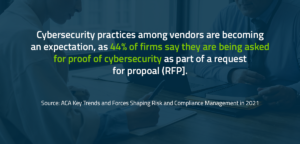Cyber risk and data privacy have been moved to the forefront of priorities for companies of all sizes – from small business to corporate enterprises. The increasing levels of cyberattacks worldwide has prompted more stringent cybersecurity regulations for many industries including fintech, healthcare and others to ensure the confidentiality, integrity, and privacy of data.
Cyber threats and data breaches can have far reaching implications for any organization. And as a way to improve cyber resiliency, collaboration between corporate stakeholders is helping organizations stay ahead of security incidents. One important collaboration is between security and compliance teams.
Tackling risk holistically requires integrating security policies and procedures with governance, risk management and compliance (GRC) programs. There is a symbiotic relationship between cybersecurity and GRC – and these interdependencies between them can be invaluable in building a comprehensive approach to risk.
Comparing Security to Compliance
Security is the practice of implementing effective systematic controls to protect company assets. The security team develops a unique system of processes, policies, and technical controls that helps determine how the organization processes, stores, consumes and disseminates data in such a way that it is protected from cyber threats.
Compliance, on the other hand, is the application of those practices to meet a third party’s government regulations, security frameworks, or contractual obligations. Compliance demonstrates that the organization meets minimum security requirements mandated by regulatory standards such as GDPR, HIPAA, PCI DSS, NIST, and SOX.
Compliance sometimes overlaps with security – but the motive behind it is different. Security is driven by technical needs, while compliance is driven by business needs. While different, both are crucial for controlling, processing, and managing sensitive data.
The Importance of Partnership
In previous eras, security and compliance teams could manage business risk in relative isolation. The expertise and day-to-day activities of each team differ quite a bit.
However, the overlap between them is significant. Both share goals of managing third-party risk, meeting regulatory requirements, responding to potential breaches, and ensuring corporate data is processed and stored securely.
And with today’s complex infrastructures and the sophistication of cyber threats, it’s no longer a case where teams can work in silos. Security and compliance teams working together makes business sense.
Let’s explore the reasons why.
-
Threats are Constantly Changing
The threat from cyberattacks is significant and continuously evolving. Devices and services are continuously connecting to these networks from all over the world, each introducing its own level of risk to the organization like never before. These vulnerabilities threaten both security and compliance.
-
Risk is a Shared Responsibility
As technology changes and expands, it brings new risk to the organization. It only takes a single vulnerability to potentially cause significant impact to an organization. Identifying and reporting risks and issues is a collective responsibility. Organizations are realizing they could be the next victim and there is no room for lax security regardless of the size of the company.
-
Internal Audits Improve Security
Internal audits play an integral role in assessing and identifying opportunities to strengthen the organization’s security. Even before an external compliance takes place, it is prudent to have internal audits to ensure the organization is fulfilling its security responsibilities. An internal auditor’s knowledge of managing risk enables them to act as a consultant providing advice and acting as a catalyst for improving security controls.
The Benefits of Tighter Integration
-
Increased efficiency
During project development, sharing responsibilities and distributing tasks to the most suitable team increases efficiency by eliminating redundancies between the two teams and by sharing resources for accomplishing similar goals. Plus, data collected in a centralized platform helps with reporting and tracking across the organization.
-
Enhanced security posture
Building a good relationship between compliance and security teams helps teams communicate and coordinate activities which are important for improving the risk posture of the organization. Discussions regarding important cybersecurity and compliance issues as well as shared insights on emerging threats and vulnerabilities goes a long way in designing better controls and in addressing areas that may have been previously overlooked. Collaboration helps shift the focus from one of blame and finger-pointing to one of remediation.
-
Better visibility across the enterprise
Once the risk landscape is better understood, teams can work together to detect threats and to mitigate them before they can do harm.
-
Increased support from leadership
Business leaders are beginning to understand that cybersecurity is more than just an IT issue. Security metrics are important, but executive teams are interested in how cybersecurity is directly related to business outcomes. When security and compliance teams come together, aligning cybersecurity to the organization’s initiatives, strategy, and overall vision increases the chances you have in securing the support of the board – which may include funding and resource allocation for future projects.
-
Avoids compliance / regulatory fines
Regulatory pressure across many industries is increasing – and so are the fines for non-compliance. As the demands of regulators increase, collaborative efforts to develop more efficient processes, controls, and communication will help increase consistency and ultimately help organizations comply with regulations.
How VULNERA Helps Security and Compliance
-
Continuously Measuring and Monitoring Risk
Continuous scanning of target environments helps teams identify and monitor risk. Data is automatically aggregated and classified by level of severity or impact it may have on critical business activities. This vulnerability intelligence allows teams to proactively identify and mitigate the areas of highest risk before they turn into more serious issues for the company.
-
VSCORE Prioritization
Helps teams determine which risk should be actioned first with automated prioritization that goes beyond a CVSS score. Also incorporates vulnerability factors:
-
Real-Time Dashboard
Data visualizations combine historical data with real-time data to help identify developing trends and to monitor effectiveness of security controls. The dashboard provides critical security data for all levels of the organization – including summaries for executive-level stakeholders.
-
Remediation Tracking
Validating the effectiveness of your security controls through automated re-testing is important to assess the success of your remediation efforts. This enables you to systematically document your conclusions, decisions, and rationale for remediation. This also satisfies compliance requirements for ensuring security measures have been implemented and have resolved the vulnerabilities.
-
Audit-Ready Reporting
Communication and collaboration are key to fostering improved corporate commitment and in developing solid relationships with key stakeholders. Audit-ready reporting ensures you can present accurate information regarding vulnerabilities and corporate risk at any point for ad-hoc requests from management and third-parties such as suppliers, customers, and security auditors.
The Results
No matter your role on the team, integrating cybersecurity with compliance helps satisfy the needs of executives, technology and security teams, and operations and project management teams.
For IT & Technology Teams
- Clear documentation improves accuracy and compliance reporting
- Retrieve audit evidence quicker and easier
- Creates a feedback loop for resources to identify and remediate issues
For CISOs
- Creates an electronic warehouse for all your compliance data
- Consolidates multiple tools into one solution
- Improves stakeholder accountability through streamlined communications
For Risk & Compliance Teams
- Mine patterns within data to pinpoint compliance issues
- Gain visibility into high-risk systems to monitor until remediation is complete
- Find and fix violations of security and compliance policies
A unified approach to security and compliance is more essential than ever. Sophisticated cyber threats are real and can threaten both the security and compliance for the organization. Security and compliance complement each other, organizations should consider combining efforts to help strengthen security controls and create documentation which aids compliance auditing.




